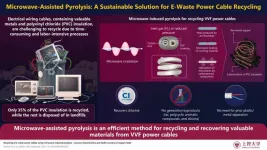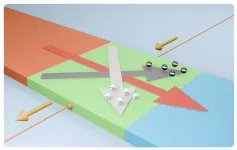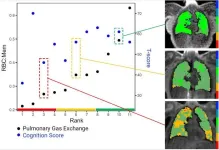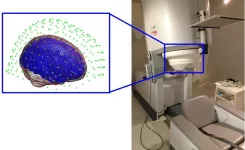(Press-News.org) SAN FRANCISCO—November 26, 2024—Subtle signs of Alzheimer’s disease can emerge decades before a diagnosis—often in the form of irregular behaviors that reflect very early stages of brain dysfunction.
But until now, identifying and measuring these slight behavioral changes in a scientific way hasn’t been feasible, not even when studying Alzheimer’s in mice.
In a study published in Cell Reports, a team of scientists at Gladstone Institutes used a new video-based machine learning tool to pinpoint otherwise-undetectable signs of early disease in mice that were engineered to mimic key aspects of Alzheimer’s. Their work sheds light on a new strategy for identifying neurological disease earlier than currently possible and tracking how it develops over time.
“We’ve shown the potential of machine learning to revolutionize how we analyze behaviors indicative of early abnormalities in brain function,” says Gladstone investigator Jorge Palop, PhD, senior author of the study. “We leveraged a valuable tool that opens the door to a more complete understanding of devastating brain disorders and how they begin.”
The scientists used a machine learning platform called VAME, short for “Variational Animal Motion Embedding,” to analyze video footage of mice exploring an open arena. The open-source tool identified subtle behavioral patterns captured on camera—changes that might not be noticed by simply looking at the mice.
Tracking Disorganized Behavior
VAME’s deep learning platform is unlike conventional behavioral tests in mice, which often center around preconceived tasks that the animals are challenged to complete.
Among the limitations of those tests, they can’t capture the full range of spontaneous behavioral changes caused by disease—particularly in early stages, explains Stephanie Miller, PhD, staff scientist at Gladstone and first author of the study. They also lack scalability and often rely on labor-intensive methods.
For the Gladstone study using VAME, the team evaluated two types of mice that simulated different aspects of Alzheimer’s. In both models, the machine learning tool identified a significantly increased level of “disorganized behavior” as the mice aged. For example, the mice exhibited unusual patterns of behavior and transitioned more often between different activities—factors that might be associated with memory and attention deficits.
“Similar machine learning approaches could be used one day to study spontaneous behaviors in humans, potentially providing early diagnosis of neurological diseases,” Miller says, noting that smartphone-quality video is sufficient for VAME analysis. “I envision this technology will be used to assess patients in the clinic and even in their homes. It gives scientists and doctors a way to solve the very hard problem of diagnosing preclinical stages of disease.”
Miller began experimenting with VAME several years ago when the technology was still in its infancy. She and Palop collaborated with the team of Stefan Remy, MD, in Germany, which initially developed the platform. Together, they helped demonstrate VAME’s utility for neuroscience research in a study published in Communications Biology.
Evaluating a Potential Treatment
Adding another dimension to their new study, the Gladstone team used VAME to learn whether a potential therapeutic intervention for Alzheimer’s would prevent the disorganized behavior in mice.
The scientists leveraged prior research from Gladstone investigator Katerina Akassoglou, PhD, who discovered that a blood-clotting protein called fibrin creates a cascade of toxic effects when it leaks into the brain through damaged blood vessels. By blocking fibrin’s toxic effects, Akassoglou’s lab has been able to prevent the neurodegeneration that leads to cognitive decline and to protect against Alzheimer’s in animals.
To find out if this therapeutic strategy could safeguard mice from Alzheimer’s-linked behaviors, the team genetically blocked fibrin from triggering toxic inflammation in the brain. This intervention reduced the development of abnormal behaviors in the Alzheimer’s mice.
“It was highly encouraging to see that blocking fibrin’s inflammatory activity in the brain reduced virtually all of the spontaneous behavioral changes in Alzheimer’s mice, reaffirming that fibrin and the ensuing neuroinflammation are key drivers of the disease,” says Akassoglou, also an author of the study. “Machine learning can offer an unbiased way to evaluate potential treatments in the lab—and I believe it may ultimately become an invaluable clinical tool, as well.”
Palop and Miller are now working with other Gladstone teams who study neurological disease to help them employ the VAME technology for new behavioral studies.
“My goal is to make this tool and similar approaches more accessible to biologists and clinicians in order to shorten the time it takes to develop powerful new medicines,” Miller says.
About the Study
The study, “Machine learning reveals prominent spontaneous behavioral changes and treatment efficacy in humanized and transgenic Alzheimer's disease models,” appears in the November 26 issue of Cell Reports. Authors include Stephanie Miller, Kevin Luxem, Kelli Lauderdale, Pranav Nambiar, Patrick Honma, Katie Ly, Shreya Bangera, Mary Bullock, Jia Shin, Nick Kaliss, Yuechen Qiu, Catherine Cai, Kevin Shen, K. Dakota Mallen, Zhaoqi Yan, Andrew Mendiola, Takashi Saito, Takaomi Saido, Alexander Pico, Reuben Thomas, Erik Roberson, Katerina Akassoglou, Pavol Bauer, Stefan Remy, and Jorge Palop.
About Gladstone Institutes
Gladstone Institutes is an independent, nonprofit life science research organization that uses visionary science and technology to overcome disease. Established in 1979, it is located in the epicenter of biomedical and technological innovation, in the Mission Bay neighborhood of San Francisco. Gladstone has created a research model that disrupts how science is done, funds big ideas, and attracts the brightest minds.
END
UCSF Benioff Children's Hospital Oakland is enrolling patients in an innovative clinical trial that seeks to cure sickle cell disease. The trial is the first in the U.S. to apply non-viral CRISPR-Cas9 gene-editing technology in humans to directly correct the genetic mutation that causes the disease.
The research involves taking the patient’s blood stem cells to correct the mutation and returning those edited cells to the patient through a bone marrow transplant. It’s hoped the corrected blood stem cells will then multiply and create a new blood system, one free of sickle cell.
“This ...
Gene editing could create hypoallergenic cats, according to a sequence analysis of the protein that triggers allergies to cats. Some 15% of people are allergic to cats, and symptoms can be severe. Martin D. Chapman and colleagues investigated CH1 and CH2, genes that code for the allergen, Fel d 1. Cats produce Fel d 1 in their sebaceous, salivary, perianal, and lachrymal glands. The function of Fel d 1 is unknown but comparisons of Fel d 1 sequences and homologs from 276 domestic or exotic cats—including cougars, cheetahs, lions, tigers, and jaguars, among others—suggests that CH1 and CH2 have been under active selection, and ...
The demand for electronics has led to a significant increase in e-waste. In 2022, approximately 62 million tons of e-waste were generated, marking an 82% increase from 2010. Projections indicate that this figure could rise to 82 million tons by 2030. E-waste contains valuable materials such as metals, semiconductors, and rare elements that can be reused. However, in 2022, only 22.3% of e-waste was properly collected and recycled, while the remaining materials, estimated to be worth almost $62 billion, were discarded in landfills. Although efforts to improve e-waste recycling continue, the process remains labor-intensive, and a significant portion of e-waste ...
Cooling systems are an integral part of many modern technologies, as heat tends to wear down materials and decrease performance in several ways. In many cases, however, cooling can be an inconvenient and energy-intensive process. Accordingly, scientists have been seeking innovative and efficient methods to cool substances down.
Solid-state optical cooling is a prominent example that leverages a very unique phenomenon called anti-Stokes (AS) emission. Usually, when materials absorb photons from incoming light, their electrons transition into an “excited” state. Under ideal conditions, as electrons return to their original ...
Thermoelectric materials, which convert heat into electricity, are valuable tools for capturing waste heat and turning it into usable electricity. These materials are especially useful in industries and vehicles where engines produce a lot of waste heat, improving energy efficiency by converting it into additional power. They also exhibit potential for portable power generation, in remote sensors and satellites where traditional power sources may be impractical.
Traditional thermoelectric devices, known as parallel thermoelectric devices, generate a voltage in the same direction as the heat ...
Recent research led by Kerstin Ozkan and published in PeerJ Life and Environment has uncovered the complex and contrasting effects of human-generated noise on Western Bluebird (Sialia mexicana) parental behavior, raising critical questions about how anthropogenic noise affects wildlife in both urban and non-urban settings. The study, titled “Divergent effects of short-term and continuous anthropogenic noise exposure on Western Bluebird parental care behavior,” explores how different types of noise exposure alter the bird's ...
Imagine gradually losing the ability to express yourself — not because you've forgotten the words, but because they simply won't come out. This is the reality for individuals living with primary progressive aphasia (PPA), a rare form of dementia that usually begins in middle age and increasingly impairs language abilities over time.
Researchers at the University of Chicago Medicine are working to illuminate the struggles of those living with this condition and pioneer accessible treatment models. They recently published new studies that measure PPA’s significant impact ...
Let’s say it’s a home game for the Golden State Warriors and Steph Curry shows he’s still got it, sinking back-to-back three-pointers minutes into the first quarter. The fans at Chase Center take notice, and so do the betting markets, where the odds move in the Warriors’ favor.
Yet it’s a long game. The away team comes back, and with just 10 seconds to go, the Warriors are down by two and have just missed a shot. A victory is unlikely, and the betting odds should have shifted to reflect that near-certainty. ...
CHICAGO – In patients with long COVID, lower pulmonary gas exchange may be associated with impaired cognitive function, according to a study being presented next week at the annual meeting of the Radiological Society of North America (RSNA).
According to the National Center for Health Statistics, approximately 17.6% of adults in the U.S. have experienced a post-COVID condition commonly referred to as long COVID. People with long COVID may exhibit a wide variety of symptoms, including difficulty concentrating (“brain fog”), change in sense of smell or taste, fatigue, joint or muscle pain, dyspnea (shortness of breath), digestive ...
CHICAGO – A new study of high school football players found that concussions affect an often-overlooked but important brain signal. The findings are being presented next week at the annual meeting of the Radiological Society of North America (RSNA).
Reports have emerged in recent years warning about the potential harms of youth contact sports on developing brains. Contact sports, including high school football, carry a risk of concussion. Symptoms of concussion commonly include cognitive disturbances, such as difficulty with balancing, ...





